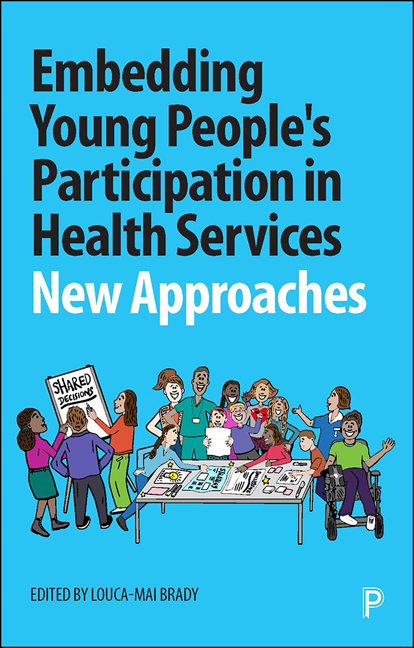Book contents
- Frontmatter
- Dedication
- Contents
- List of Boxes, Figures and Tables
- Summary
- Notes on Contributors
- Acknowledgements
- Foreword
- Introduction: Embedding Young People’s Participation in Healthcare
- PART I Young People’s Participation in Individual Decision-Making
- PART II Participation in National Projects and Programmes
- PART III Collaborative Research in NHS Services
- PART IV Young People-led Participation
- Index
2 - Disabled Young People’s Participation in End-of-Life Decisions
Published online by Cambridge University Press: 25 February 2021
- Frontmatter
- Dedication
- Contents
- List of Boxes, Figures and Tables
- Summary
- Notes on Contributors
- Acknowledgements
- Foreword
- Introduction: Embedding Young People’s Participation in Healthcare
- PART I Young People’s Participation in Individual Decision-Making
- PART II Participation in National Projects and Programmes
- PART III Collaborative Research in NHS Services
- PART IV Young People-led Participation
- Index
Summary
Introduction
This chapter draws on my academic research and lived experience as mum to Adam. My research explored how UK paediatrians make end-of-life decisions for disabled children and young people, and how they use, or choose not to use the law and professional guidance in those decisions (Picton-Howell, 2018). Adam lived with severe physical impairment. He was educationally bright. He spent, in total, eight years of his life in hospital, meaning so did I. Adam acquired severe cerebral palsy at birth in 2000 and developed significant complex health problems. He died from sepsis in 2015.
Background
Adam's healthcare experience was extensive; with care in seven tertiary, district and specialist children's hospitals across the UK. He was treated by health professionals with expertise in a broad range of health conditions. He had daily contact with NHS staff on almost every day of his life.
Over the years, I noticed differences in how health professionals engaged with Adam. Nurses, therapists and doctors who were not paediatricians (doctors specialising in the treatment of children and young people), for example general practitioners, tended to engage with Adam, including him in decisions, without difficulty. In contrast, while some paediatricians engaged with him, many did not, assuming, based on Adam's physical impairment and health problems, that he was unable to communicate or understand. I noticed that female and younger paediatricians were more likely to engage with Adam, and male and older paediatricians were less likely to do so.
The context of Adam's life more generally is perhaps relevant here. He attended mainstream school and was always at the top end of the ability range educationally for his age. He blogged and wrote poetry and as a teenager was regularly commissioned to write by the NHS nationally and by charities. He won multiple national and international awards for his writing and advocacy. He was interviewed by regional and national media. What perhaps surprised me most is that some paediatricians, even when they were told all this by me or their colleagues, still insisted Adam could not understand or communicate.
Adam's main method of communication was blinking. At its most simple, he would blink for ‘yes’ and give an obvious stare for ‘no’, but he developed sophisticated methods enabling him to discuss complex ideas.
- Type
- Chapter
- Information
- Embedding Young People's Participation in Health ServicesNew Approaches, pp. 53 - 74Publisher: Bristol University PressPrint publication year: 2020



